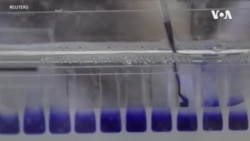ນັກວິທະຍາສາດອາເມຣິກັນ ແລະຮັງກາຣິີ ຜູ້ທີ່ໄດ້ຮ່ວມກັນເພື່ອບຸກເບີກນະວັດຕະກຳໃໝ່ດ້ານເທັກໂນໂລຈີ ຢູ່ເບື້ອງຫລັງຢາວັກຊີນກັນໂຄວິດຈຳນວນນຶ່ງທີ່ໄດ້ຜົນທີ່ສຸດ ຊຶ່ງໄດ້ຮັບລາງວັນໂນແບລດ້ານການແພດປະຈຳປີ 2023 ຊຶ່ງເປັນລາງວັນທີ່ມີກຽດສູງສຸດທີ່ມອບໃຫ້ໃນຂະແໜງການດັ່ງກ່າວ. ເຮັນຣີ ຣິຈແວລ ມີລາຍງານ ຊຶ່ງກິ່ງສະຫວັນ ມີລາຍລະອຽດກ່ຽວກັບເລື້ອງນີ້.
ເທັກໂນໂລຈີ ‘mRNA’ ມີຄວາມສຳຄັນ ໃນການພັດທະນາຢາວັກຊິນກັນໄວ ຣັສໂຄໂຣນາ ຂອງບໍລິສັດ Moderna ແລະ Pfizer-BioTech.
ນັກວິທະຍາສາດອາເມຣິກັນເຊື້ອສາຍຮັງກາຣີ ທ່ານນາງກາຕາລິນ ກາຣິໂກ ແລະເພື່ອນຮ່ວມງານຄົນອາເມຣິກັນ ທ່ານດຣູ ວາຍສແມນ ໄດ້ເລີ້ມເຮັດວຽກກ່ຽວກັບເທັກໂນໂລຈີ mNRA ໃນຕົ້ນຊຸມປີ 1990 ຢູ່ມະຫາວິທະຍາໄລເພັນຊີນເວເນຍ.
ຄະນະກຳມະການລາງວັນໂນແບລ ຢູ່ໃນສະວີເດັນ ກ່າວວ່າ ການຄົ້ນພົບນີ້ໄດ້ຊ່ວຍໃຫ້ເອົາຊະນະນຶ່ງໃນໄພຂົ່ມຂູ່ທີ່ໃຫຍ່ສຸດ ຕໍ່ສຸຂະພາບຂອງມວນມະ ນຸດໃນຍຸກສະໄໝໃໝ່.
ທ່ານຣິເຈີດ ແຊນເບີກ ຄະນະກຳມະການຄົນນຶ່ງ ຂອງລາງວັນໂນແບລ ຂະ ແໜງການແພດ ກ່າວວ່າ:
“mRNA ວັກຊິນ ພ້ອມກັບວັກຊິນກັນໂຄວິດ-19 ອື່ນໆ ໄດ້ມີການຊັກ 13 ພັນລ້ານເທື່ອ. ພ້ອມກັນນີ້ ຢາດັ່ງກ່າວໄດ້ຊ່ວຍຫລາຍລ້ານຊີວິດປ້ອງກັນໂຄວິດ-19 ທີ່ຮ້າຍແຮງ ຫລຸດຜ່ອນຄວາມເສຍຫາຍຈາກພະຍາດທັງໝົດ ແລະຊ່ວຍບັນດາປະຊາຄົມ ໃຫ້ເປີດກວ້າງຄືນໃໝ່ອີກ."
mRNA ຫລືຜູ້ສົ່ງຂ່າວ RNA ສັ່ງໃຫ້ແຊລ ຜະລິດໂປຣຕິນແບບດຽວກັນກັບ ທີ່ໄດ້ພົບເຫັນຢູ່ດ້ານນອກຂອງເຊື້ອພະຍາດ ຄືດັ່ງໄວຣັສໂຄໂຣນາ. ຮ່າງກາຍເຫັນສິ່ງເຫລົ່ານີ້ວ່າເປັນພວກຮຸກຮານ ແລະຜະລິດພູມຕ້ານຮ່າງກາຍ ແລະ T-cells ເພື່ອໂຈມຕີພວກເຂົາ ດັ່ງນັ້ນຈຶ່ງເປັນການເຝິກຊ້ອມພວກເຂົາ ເພືື່ອປະເຊີນໜ້າກັບໄວຣັສທີ່ແທ້ຈິງໃນອະນາຄົດ.
ໃນປີ 2005 ທ່ານນາງກາຣິໂກແລະທ່ານວາຍສແມນ ໄດ້ຊອກຫາຊ່ອງທາງ ເພື່ອຢຸດຢັ້ງລະບົບພູມຄຸ້ມກັນຈາກການໂຈມຕີ RNA ທີ່ເຮັດຂຶ້ນຢູ່ໃນຫ້ອງທົດລອງ ຊຶ່ງກ່ອນໜ້ານັ້ນ ຖືກເບິ່ງກັນວ່າ ເປັນອຸບປະສັກອັນສຳຄັນສຳລັບການນຳໃຊ້. ທ່ານນາງກາຣິໂກ ໄດ້ກ່າວໃນວັນຈັນຜ່ານມານີ້ວ່າ ເຂົາເຈົ້າໄດ້ກາຍເປັນທີມງານທີິ່ດີ.
ທ່ານນາງຄາຕາລິນ ກາຣິໂກ ຜູ້ຊະນະລາງວັນໂນແບລ ດ້ານການແພດປີ 2023 ກ່າວວ່າ:
“ຂ້າພະເຈົ້າເປັນຄົນ RNA ແລະທ່ານດຣູໄດ້ເປັນນັກພູມຄຸ້ມກັນວິທະຍາແລະພວກເຮົາໄດ້ສິດສອນກັນແລະກັນ. ແລະພ້ອມດຽວກັນ ພວກເຮົາກໍໄດ້ຮຽນຮູ້ຈາກກັນ ແລະກັນ ແລະພັດທະນາ mRNA.”
ທ່ານວາຍສແມນໄດ້ກ່າວວ່າ ຄວາມເປັນໄປໄດ້ໃນອະນາຄົດສຳລັບ mRNA ແມ່ນບໍ່ໜ້າເຊື່ອ.
ທ່ານດຣູ ວາຍສແມນ ຜູ້ຊະນະລາງວັນໂນແບລ ດ້ານການແພດປີ 2023 ກ່າວວ່າ:
“ພວກເຮົາໄດ້ຄຶດມາເປັນເວລາຫລາຍປີ ກ່ຽວກັບທຸກສິ່ງຢ່າງ ທີ່ພວກເຮົາສາ ມາດເຮັດໄດ້ ກັບ RNA ແລະບັດນີ້ ມັນຢູ່ທີ່ນີ້ແລ້ວ.”
ການລະບາດຂອງໄວຣັສໂຄໂຣນາ ໄດ້ເລັ່ງລັດ ການພັດທະນາເທັກໂນໂນຈີ mRNA ນັ້ນຄືຄຳເວົ້າຂອງນັກວິທະຍາສາດ ທ່ານໂພລ ຮັນເຕີ.
ທ່ານໂພລ ຮັນເຕີ ສາດສະດາຈານດ້ານການແພດ ຈາກມະຫາວິທະຍາໄລ East Angelia ກ່າວວ່າ:
“ກ່ອນໂຄວິດ-19 ຜູ້ຄົນຮູ້ວ່າ ວຽກການໄດ້ສຳເລັດເສັດສິ້ນກ່ຽວກັບຢາວັກຊິນ mRNA. ແຕ່ຂ້າພະເຈົ້າບໍ່ຄິດວ່າ ພວກເຮົາຍັງບໍ່ໄດ້ເຂົ້າໃກ້ເລີຍ ກັບໂລກທີ່ ແທ້ຈິງໃນການໃຊ້ເທັກໂນໂລຈີດັ່ງກ່າວ. ບັດນີ້ ມັນໄດ້ສະແດງໃຫ້ເຫັນວ່າມັນໄດ້ຜົນ ເຮັດວຽກອາດໄດ້ດີຂຶ້ນກວ່າຢາວັກຊີນຫລາຍຊະນິດ ຖ້າບໍ່ແມ່ນດີສຸດ ຂ້າພະເຈົ້າຄິດວ່າ ເປັນການເພີ້ມປະສິດທິພາບຢ່າງໃຫຍ່ແກ່ມັນ ແລະກໍອາດມີຄວາມສາມາດຢ່າງຫຼວງຫຼາຍໃນການນຳໃຊ້ເທັກໂນໂລຈີນີ້.”
ມີຫວັງວ່າ ເທັກໂນໂລຈີ mRNA ມື້ໃດມື້ນຶ່ງຂ້າງໜ້າອາດສາມາດນຳໃຊ້ເພື່ອຕໍ່ສູ້ກັບໂຣກມະເຮັງ.
ທ່ານກູນິລລາ ຄາຣິສສັນ ຮີແດສຕໍາ ເປັນປະທານຄະນະກຳມະການລາງວັນໂນແບລ ດ້ານການແພດ ຊຶ່ງທ່ານກ່າວວ່າ:
“ຢາວັກຊີນທີ່ແນເປົ້າໝາຍໃສ່ເນື້ອງອກທີ່ສະເພາະເຈາະຈົງ ບາງທີອາດແມ່ນແຕ່ສະເພາະສ່ວນບຸກຄົນ ຫລືມະເຮັງສ່ວນໂຕ.”
ທ່ານນາງກາຣິໂກ ແລະທ່ານວາຍສແມນແບ່ງປັນລາງວັນນຶ່ງລ້ານໂດລາແລະຈະໄດ້ຮັບຫລຽນ ຢູ່ໃນພິທີ ຈັດຂຶ້ນທີ່ນະຄອນຫຼວງສະຕັອກໂຮມໃນທ້າຍປີນີ້.
An American and a Hungarian scientist who jointly worked on the ground-breaking technology behind some of the most effective COVID vaccines have been awarded the 2023 Nobel Prize for medicine — one of the most prestigious accolades in the field.
‘mRNA’ technology was crucial in developing the Moderna and Pfizer-BioNtech coronavirus vaccines.
Hungarian American scientist Katalin Kariko and her American colleague Drew Weissman began working on mRNA technology in the early 1990s at the University of Pennsylvania.
The Nobel Prize committee in Sweden said the discovery had helped defeat one of the greatest threats to human health in modern times.
“mRNA vaccines, together with other COVID-19 vaccines, have been administered over 13 billion times. Together, they have saved millions of lives, prevented severe COVID-19, reduced the overall disease burden, and enabled societies to open up again.”
mRNA — or messenger RNA — instructs cells to make proteins that match those found on the surface of pathogens, like the coronavirus. The body sees these as invaders and makes antibodies and T-cells to attack them — thus training it to deal with a real virus in the future.
In 2005, Kariko and Weissman worked out a way to stop the immune system from attacking RNA made in the laboratory — previously seen as a major hurdle against its use. Kariko said Monday they made a good team.
“I was the RNA person and Drew was (the) immunologist, and we educated each other. And together we learned [from] each other and developed mRNA.”
Weissman said the future potential for mRNA was incredible.
“We've been thinking for years about everything that we could do with RNA, and now it's here.”
The coronavirus pandemic accelerated the development of mRNA technology, says scientist Paul Hunter.
“Prior to COVID, people knew that work was being done on mRNA vaccines. But I don’t think we were ever close to getting real-world use of the technology. Now that it’s been shown to work — to work probably better than many if not most other vaccine types — I think is a big boost to it, and there are a substantial number of potential uses of this technology.”
It’s hoped mRNA technology could one day be used to fight cancer.
“Vaccines that are targeted towards specific kinds of tumors, maybe even to specific individuals or personalized cancers.”
Kariko and Weissman share the prize of one million dollars — and will receive their medals at a ceremony in Stockholm later this year.





